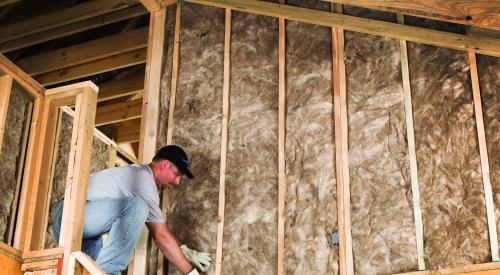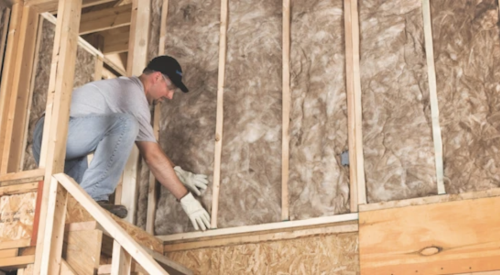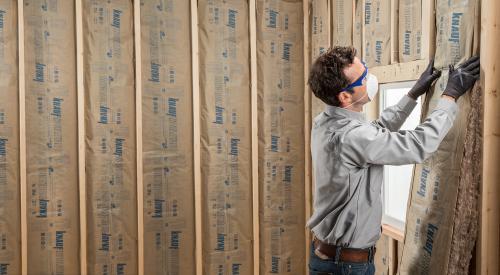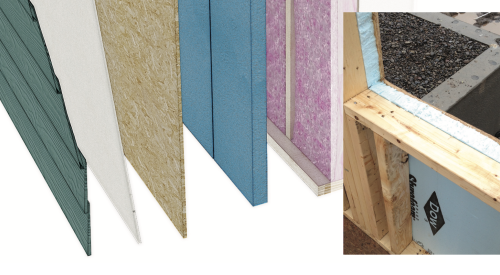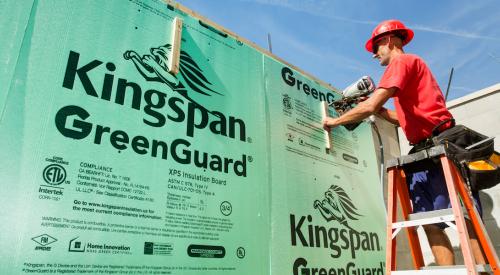 Spray-in foam insulation products use a blowing agent to help the material expand to many times its size when applied. Photo credit: BASF |
The first measure of insulation performance is the R-value, which is derived from standardized tests that determine how well the materials resist heat flow and air infiltration. Current standards in most parts of the U.S. call for at least R-13 exterior walls and R-38 ceilings. It's no coincidence that R-values are the first numbers a manufacturer will trot out to the public. But depending on the climate, quality of work and the rest of the building envelope, an R-value can become quite relative. Prices have come down with some alternate insulation products, but there's a bit of a trade-off: as the R-value goes up, so does the cost.
A majority of home builders still uses fiberglass batts as the first line of defense against air infiltration, but it's not necessarily known as being green — what your home buyers might be asking for. Increasingly, the materials we put inside our walls and ceilings can be categorized as "green"; recycled newsprint, soybean-based blown-in insulation and other sustainable methods and materials are much more commonplace than they were even five years ago.
 Fiberglass insulation is still the most commonly applied method of keeping the drafts out and the heat in. Photo credit: Aquaset |
It was the housing boom and successive green movement that gave the insulation industry a kick in the pants. And sometimes it wasn't what the manufacturers put into their products so much as what came out. New formulas removed or replaced environmentally harmful or hazardous ingredients. On a smaller but no less important scale are natural products that form the basis of insulation like cotton, wool and soybeans.
Although there is no perfect insulation method yet, there's a range of products that can meet your company's needs and budget. Use the chart on the following pages to get a quick run-down of the major choices the industry has to offer.
| Closed Cell | Open Cell | Fiberglass batts | Cellulose | Mineral Fiber | Soybean-Based | |
| Properties: | Cells inside the insulation resemble inflated balloons | Open-cell spray foam is found in densities ranging from 0.4 to 1.2 lbs./ft3. | Composed of Silica spun into fibers | Made from recycled paper and paper waste with up to 20% of the material composed of ammonium sulfate or boric acid | Has the look and feel of fiberglass | Rigid or flexible soy-based polyurethane plastic created from isocyanate and soybean oil-based polyol |
| Made from Isocyanate and a resin compound | R-values of about 3.5 per inch | Facing material acts as an air barrier | Come in both loose and damp forms | Made from steel slag spun into fibers | Various mixtures available for different spraying methods | |
| Inherent moisture vapor retarder (0.1 perm-in. per ASTM E-96 or better) | Softer, sponge-like appearance | Newer "green" fiberglass insulations made with recycled content | Excellent acoustic performance | Treated with binders and oil | ||
| Can be woven into batts | ||||||
| Installation Method: | Spray-in system, usually installed by manufacturer-certified installers | Can be applied as a liquid or sprayed by certified installers | Batts fit into building cavities and come in rolls or can be blown-in | Must be blown-in to predicted settled density to achieve its rated R-value | Like fiberglass, the materials used in mineral fiber can be spun into batts manufactured to fit the standard spaces between studs | Applied as a liquid sprayed-in with a water-based delivery system to expand to 100 times its size |
| A foam machine mixes Isocyanate and resin and the two compounds are heated and mix together when sprayed | The flexible foam expands to many times its size to fill in space | Installers require protective clothing and respirators | Can be damp-sprayed into open wall cavities before drywall is installed | |||
| Benefits: | Uses non-ozone-depleting hydrochlorofluorocarbons (HCFCs) as opposed to CFCs | Excellent insulating, sound resistance and air barrier properties | Least expensive, quick installation times when compared to other methods | Most cellulose is made from about 80% recycled materials | Mineral fibers made from waste materials | Contains none of the formaldehyde found in some fiberglass batts |
| Ideal for preventing condensation buildup and an excellent thermal barrier with a long life expectancy | More permeable to moisture vapor, with ratings of about 10.0 per 4-5 inch thickness | High-density batts offer high R-values | Provides a general R-value of 4 as it seals all cavity spaces | Mineral fibers are inherently stable | Unaffected by time or moisture, highly resistant to mold and mildew | |
| Fire- and moisture-resistant | Greatly reduces sound transmission | Non-combustible, fire retardant and can create 1- and 2-hour rated fire walls | Most are Class-1 fire rated | |||
| Can be composted/recycled at the end of its life cycle | ||||||
| Stabilizers reduce settling over time | ||||||
| Note: In moderate climates, the minimum recommended R-value is R-30 for an attic, R-11 for walls, R-19 for raised floors and R-4.2 for ductwork. | ||||||
